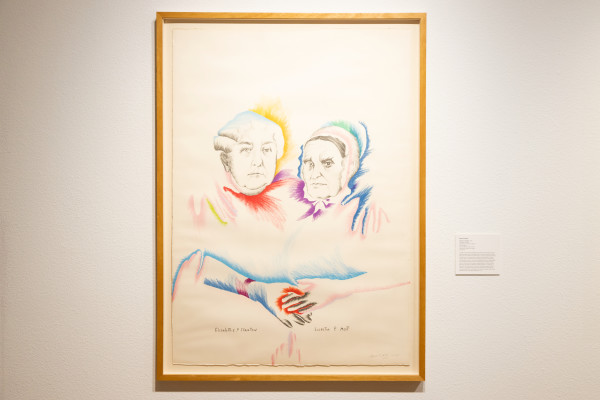Excerpts: Works from the Marjorie Barrick Museum of Art Collections
- August 17, 2020 - December 18, 2020
- Exhibition
- /
- Artwork
- /
- Artists
-
Marisol Escobar (French, 1930-2016) x
Marisol Escobar was born in Paris to Venezuelan parents. World War II drove the family out of Europe in 1941. They settled in California. In 1949 she returned to Paris to attend the Ecole des Beaux-Arts but by 1950 she was studying painting in New York, first at the Art Students League, then the Hans Hofmann School. Exposure to Pre-Colombian artifacts and various forms of folk art shifted her interest from painting to sculpture. She taught herself to work on a small scale in terracotta and wood.
In 1955 she began to operate at a more formidable size, dressing her figures in adult clothes and incorporating plaster, rubber, televisions, necklaces, and other found objects. Her assemblages are autobiographical, critical, and satirical, sometimes commenting on social pressures and constraints from the point of view of isolated participants (The Party, 1955-1966, with her face in rubber appearing on every figure), sometimes making broader points about politics (LBJ, 1967) or oppression.
Escobar held her first one-woman show at the Leo Castelli Gallery, NY, in 1958. Her friendships with Andy Warhol and Roy Lichtenstein, coupled with the irreverent social engagement of her mixed-media work, have meant that she is often categorized as a Pop Artist, although the incorporation of folk art fetishes and motifs sets her apart from the more purely contemporary iconography of her peers.
The size of her objects diminished during the 1970s, and two-dimensional work returned more prominently to her oeuvre. In the 1980s her interest in portraiture and the human figure culminated in large sculptures.
Her work is held by the Museum of Modern Art, NY, the Whitney Museum, the Albright-Knox Museum in Buffalo, and the Art Museum of the Americas.
DK Sole, UNLV Marjorie Barrick Museum 2013
Bibliography:
Anonymous, Marisol: Baby Girl, 1963, Albright-Knox Museum
Anonymous, The Party, Toledo Museum of Art

